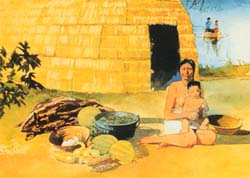
 |
Agriculture | |
| Closeup of Illinois woman with some of the produce from her garden, including corn, beans, squash, and watermelon. Most crops raised by the Illinois were domesticated in prehistoric times by American Indians living in the New World. However, watermelons were domesticated in Africa and later introduced to North America by Spanish colonists living in what is today Florida or New Mexico. | ||
They live on indian corn and other fruits of the earth, which they cultivate, like the other savages, on the prairies. (Claude Allouez, 1677)![]()
Maize (corn) was the most important crop, but the Illinois also raised beans, squash, bottle gourds, pumpkins, and watermelons. Women prepared their fields and began planting maize in early May. The first of two maize harvests came in late July, when ears were in the green stage. Green maize was usually preserved by scraping the tender kernels from the cobs using mussel shells, boiling the kernels, and then spreading them out on reed mats to dry. The second harvest occurred in late August when the maize had ripened. Large quantities of dried maize were stored in underground pits to be eaten during the lean winter months.![]()
|
|
Copyright © 2000 Illinois State Museum